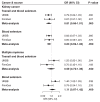Selenium and cancer risk: Wide-angled Mendelian randomization analysis
- PMID: 34910310
- PMCID: PMC7613914
- DOI: 10.1002/ijc.33902
Selenium and cancer risk: Wide-angled Mendelian randomization analysis
Abstract
Evidence on the association between selenium and cancer risk is inconclusive. We conducted a Mendelian randomization study to examine the associations of selenium levels with 22 site-specific cancers and any cancer. Single nucleotide polymorphisms (SNPs) strongly associated with toenail and blood (TAB) and blood selenium levels in mild linkage disequilibrium (r2 < .3) were used as instrumental variables. Genetic associations of selenium-associated SNPs with cancer were obtained from the UK Biobank including a total of 59 647 cancer cases and 307 914 controls. Associations with P < .1 in UK Biobank were tested for replication in the FinnGen consortium comprising more than 180 000 individuals. The inverse-variance weighted method accounting for linkage disequilibrium was used to estimate the associations. Genetically predicted TAB selenium levels were not associated with the risk of the 22 site-specific cancers or any cancer (all 22 site-specific cancers). Similarly, we observed no strong association for genetically predicted blood selenium levels. However, genetically predicted blood selenium levels showed suggestive associations with risk of kidney cancer (odds ratio [OR] per one-unit increase in log-transformed levels: 0.83; 95% confidence interval [CI]: 0.67-1.03) and multiple myeloma (OR: 1.40; 95% CI: 1.02-1.93). The same direction of association for kidney cancer but not for multiple myeloma was observed in FinnGen. In the metaanalysis of UK Biobank and FinnGen, the OR of kidney cancer was 0.83 (95% CI: 0.69-1.00). Our study suggests that high selenium status may not prevent cancer development. The associations for kidney cancer and multiple myeloma need to be verified in well-powered studies.
Keywords: Mendelian randomization; cancer; kidney cancer; selenium.
© 2021 The Authors. International Journal of Cancer published by John Wiley & Sons Ltd on behalf of UICC.
Conflict of interest statement
All authors declare no conflict of interest.
Figures


Similar articles
-
Sleep duration and risk of overall and 22 site-specific cancers: A Mendelian randomization study.Int J Cancer. 2021 Feb 15;148(4):914-920. doi: 10.1002/ijc.33286. Epub 2020 Sep 14. Int J Cancer. 2021. PMID: 32895918 Free PMC article.
-
Genetically predicted selenium concentrations and thyroid function: A two-sample Mendelian randomization study.Clin Endocrinol (Oxf). 2023 Jun;98(6):813-822. doi: 10.1111/cen.14867. Epub 2022 Dec 25. Clin Endocrinol (Oxf). 2023. PMID: 36536522
-
Associations between psoriasis and risk of 33 cancers: a Mendelian randomization study.BMC Cancer. 2025 May 7;25(1):837. doi: 10.1186/s12885-025-14243-4. BMC Cancer. 2025. PMID: 40335896 Free PMC article.
-
[Genetic Causation Analysis of Hyperandrogenemia Testing Indicators and Preeclampsia].Sichuan Da Xue Xue Bao Yi Xue Ban. 2024 May 20;55(3):566-573. doi: 10.12182/20240560106. Sichuan Da Xue Xue Bao Yi Xue Ban. 2024. PMID: 38948277 Free PMC article. Chinese.
-
Health effects of milk consumption: phenome-wide Mendelian randomization study.BMC Med. 2022 Nov 23;20(1):455. doi: 10.1186/s12916-022-02658-w. BMC Med. 2022. PMID: 36424608 Free PMC article.
Cited by
-
Comparative Study of Red and Grey Selenium Nanoparticles on Organ-Specific Selenium Deposition and Growth Performance in Japanese Quails.Nanomaterials (Basel). 2025 May 27;15(11):801. doi: 10.3390/nano15110801. Nanomaterials (Basel). 2025. PMID: 40497850 Free PMC article.
-
An atlas of associations between 14 micronutrients and 22 cancer outcomes: Mendelian randomization analyses.BMC Med. 2023 Aug 21;21(1):316. doi: 10.1186/s12916-023-03018-y. BMC Med. 2023. PMID: 37605270 Free PMC article.
-
The Relationship between Changes in Serum Element Concentrations and Pathological Condition and Disease Status in Japanese Multiple Myeloma Patients: A Pilot Study and Literature Review.Asian Pac J Cancer Prev. 2023 Jul 1;24(7):2493-2503. doi: 10.31557/APJCP.2023.24.7.2493. Asian Pac J Cancer Prev. 2023. PMID: 37505784 Free PMC article. Review.
-
The Mediation/Moderation Effects of Gut Microbiota on Sleep Quality and Primary Liver Cancer: A Mendelian Randomization and Case-Control Study.Nat Sci Sleep. 2024 Jun 1;16:663-674. doi: 10.2147/NSS.S458491. eCollection 2024. Nat Sci Sleep. 2024. PMID: 38841051 Free PMC article.
-
Potential therapeutic targets for bladder cancer: a proteome-wide Mendelian randomization study.Am J Cancer Res. 2025 Mar 15;15(3):1096-1108. doi: 10.62347/UBEJ3345. eCollection 2025. Am J Cancer Res. 2025. PMID: 40226474 Free PMC article.
References
-
- Rayman MP. Selenium and human health. Lancet. 2012;379:1256–1268. - PubMed
-
- Rayman MP. Selenium in cancer prevention: a review of the evidence and mechanism of action. Proc Nutr Soc. 2005;64:527–542. - PubMed
-
- Vinceti M, Filippini T, Wise LA. Environmental selenium and human health: an update. Curr Environ Health Rep. 2018;5:464–485. - PubMed
-
- Kuria A, Fang X, Li M, et al. Does dietary intake of selenium protect against cancer? A systematic review and meta-analysis of population-based prospective studies. Crit Rev Food Sci Nutr. 2020;60:684–694. - PubMed
Publication types
MeSH terms
Substances
Grants and funding
LinkOut - more resources
Full Text Sources
Medical

